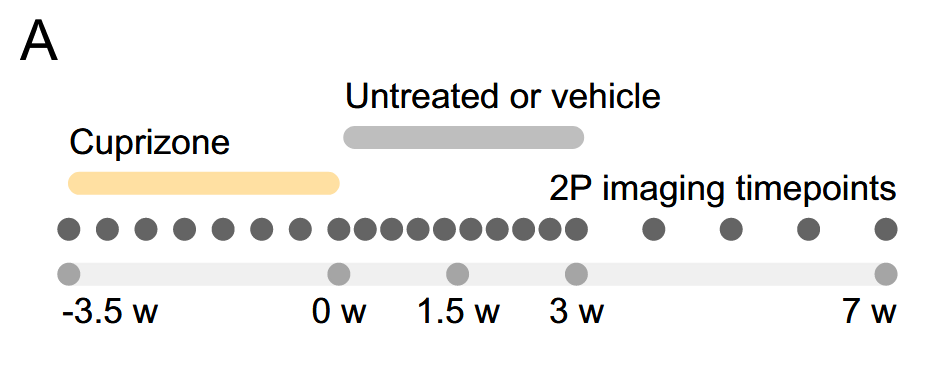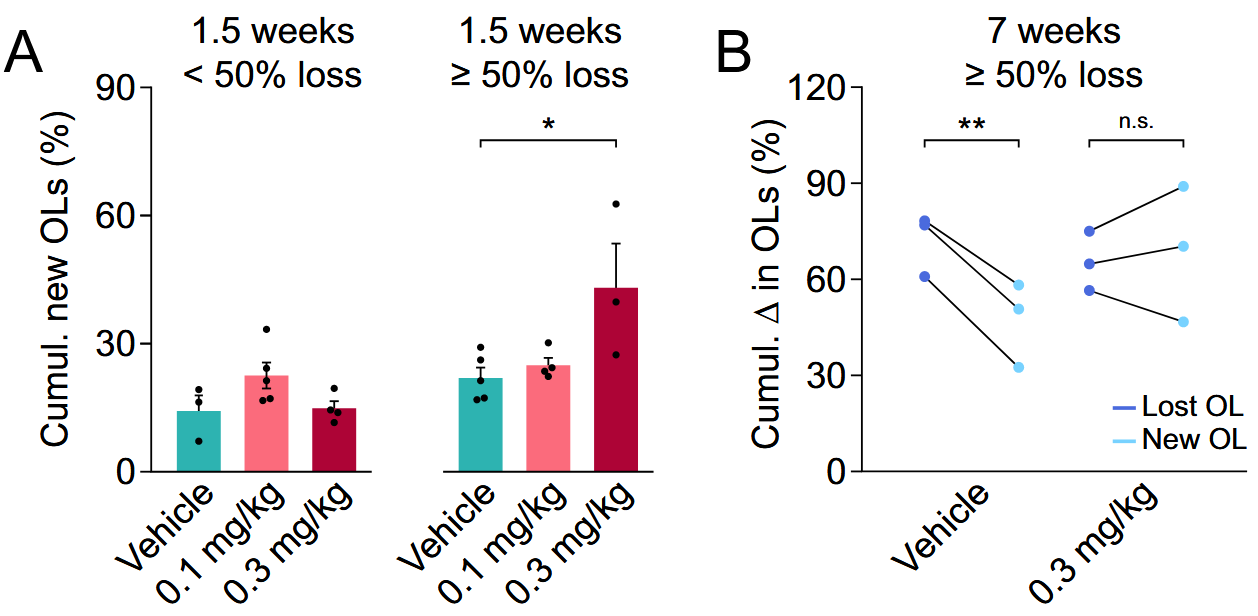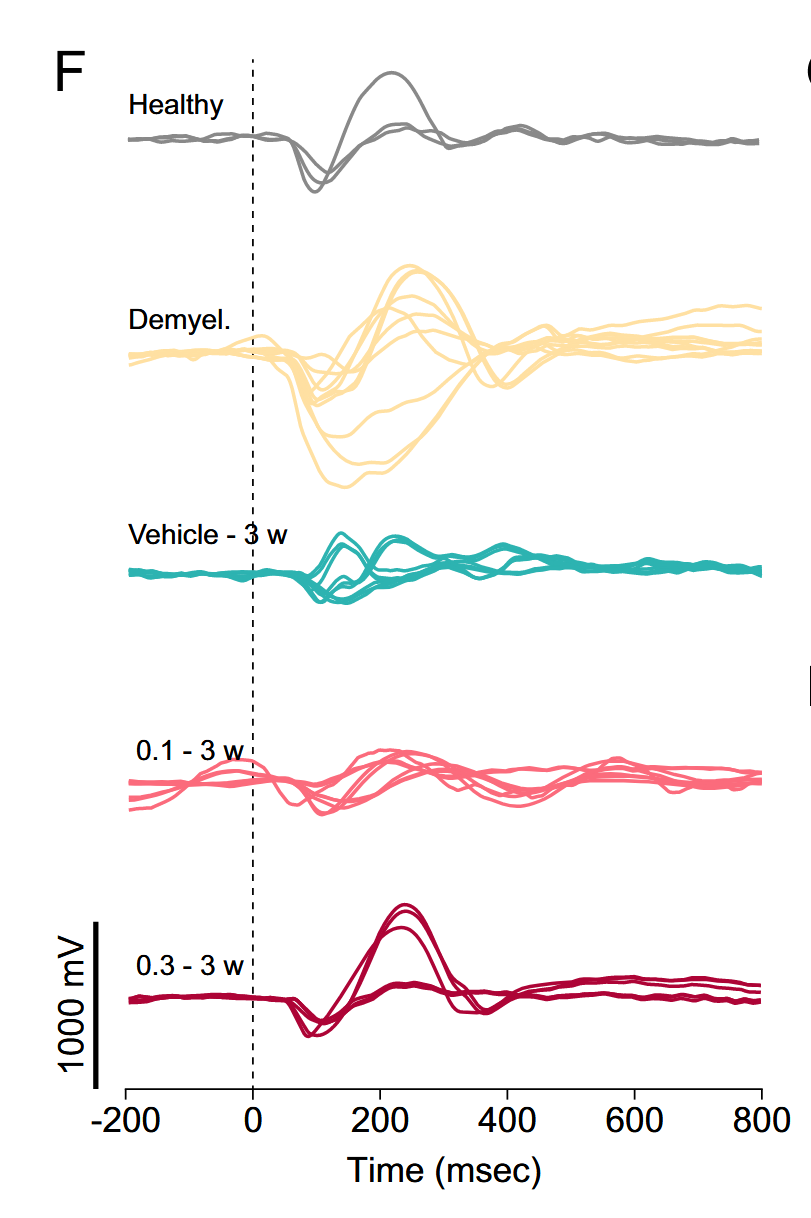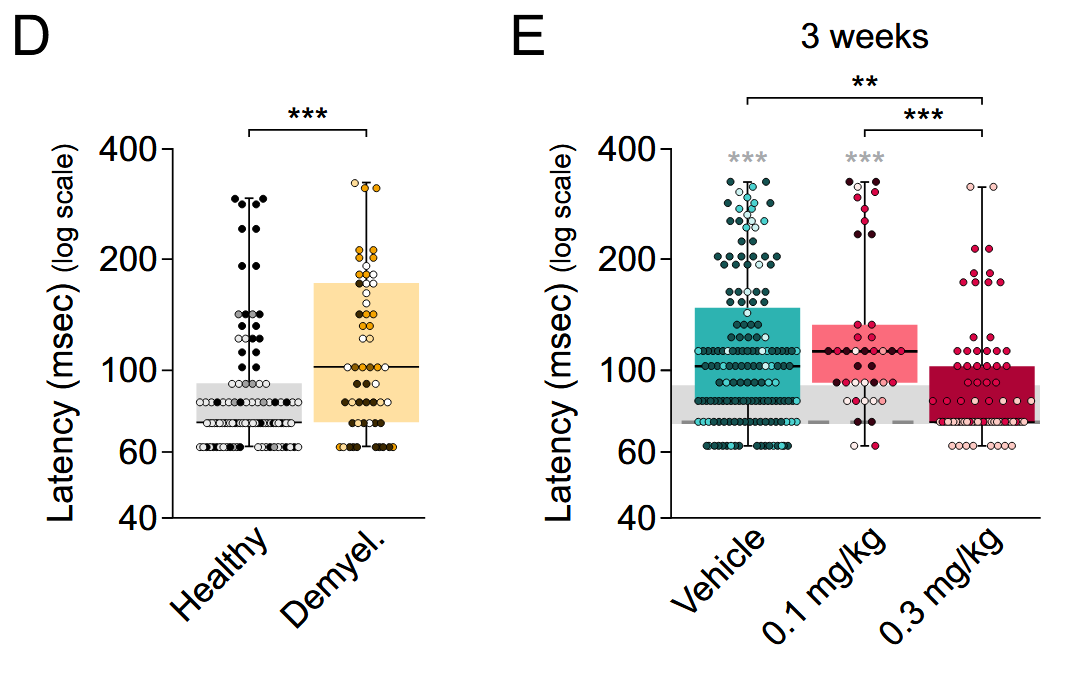Reference
Della-Flora Nunes, G., Osso, L. A., Haynes, J. A., Conant, L., Thornton, M. A., Stockton, M. E., Brassell, K. A., Morris, A., Mancha Corchado, Y. I., Gaynes, J. A., Chavez, A. R., Woerner, M. B., MacKenna, D. A., Alavi, A., Danks, A., Poleg-Polsky, A., Gandhi, R., Vivian, J. A., Denman, D. J., & Hughes, E. G. (2025). Incomplete remyelination via therapeutically enhanced oligodendrogenesis is sufficient to recover visual cortical function. Nature Communications, 16(1), 732. https://doi.org/10.1038/s41467-025-56092-6
Info
FirstAuthor:: Della-Flora Nunes, Gustavo
Author:: Osso, Lindsay A.
Author:: Haynes, Johana A.
Author:: Conant, Lauren
Author:: Thornton, Michael A.
Author:: Stockton, Michael E.
Author:: Brassell, Katherine A.
Author:: Morris, Amanda
Author:: Mancha Corchado, Yessenia I.
Author:: Gaynes, John A.
Author:: Chavez, Anthony R.
Author:: Woerner, Michaelanne B.
Author:: MacKenna, Deidre A.
Author:: Alavi, Aryan
Author:: Danks, Anne
Author:: Poleg-Polsky, Alon
Author:: Gandhi, Rohan
Author:: Vivian, Jeffrey A.
Author:: Denman, Daniel J.
Author:: Hughes, Ethan G.
~
Title:: Incomplete remyelination via therapeutically enhanced oligodendrogenesis is sufficient to recover visual cortical function
Year:: 2025
Citekey:: Della-FloraNunesEtAl_2025_IncompleteRemyelinationTherapeutically
itemType:: journalArticle
Journal:: Nature Communications
Volume:: 16
Issue:: 1
Pages:: 732
DOI:: 10.1038/s41467-025-56092-6
Link
Abstract
Myelin loss induces neural dysfunction and contributes to the pathophysiology of neurodegenerative diseases, injury conditions, and aging. Because remyelination is often incomplete, better understanding endogenous remyelination and developing remyelination therapies that restore neural function are clinical imperatives. Here, we use in vivo two-photon microscopy and electrophysiology to study the dynamics of endogenous and therapeutic-induced cortical remyelination and functional recovery after cuprizone-mediated demyelination in mice. We focus on the visual pathway, which is uniquely positioned to provide insights into structure-function relationships during de/remyelination. We show endogenous remyelination is driven by recent oligodendrocyte loss and is highly efficacious following mild demyelination, but fails to restore the oligodendrocyte population when high rates of oligodendrocyte loss occur quickly. Testing a thyromimetic (LL-341070) compared to clemastine, we find it better enhances oligodendrocyte gain and hastens recovery of neuronal function. The therapeutic benefit of the thyromimetic is temporally restricted, and it acts exclusively following moderate to severe demyelination, eliminating the endogenous remyelination deficit. However, we find regeneration of oligodendrocytes and myelin to healthy levels is not necessary for recovery of visual neuronal function. These findings advance our understanding of remyelination and its impact on functional recovery to inform future therapeutic strategies.
Blue: Important conclusions
Highlight ( Page )
endogenous remyelination is driven by recent oligodendrocyte loss and is highly efficacious following mild demyelination, but fails to restore the oligodendrocyte population when high rates of oligodendrocyte loss occur quickly.
Highlight ( Page )
thyromimetic (LL-341070) compared to clemastine, we find it better enhances oligodendrocyte gain and hastens recovery of neuronal function.
Highlight ( Page )
regeneration of oligodendrocytes and myelin to healthy levels is not necessary for recovery of visual neuronal function.
Highlight ( Page 2)
Treatment with a high dose of LL-341070 substantially increased regenerative oligodendrogenesis during remyelination, acting more quickly and robustly than clemastine, and hastened neuron functional recovery. The therapeutic benefit of LL-341070 was loss-dependent, exclusively impacting remyelination after moderate or severe demyelination.
Highlight ( Page 2)
LL-341070 eliminated the endogenous remyelination deficit after seven weeks of remyelination, restoring oligodendrocyte numbers to original levels and myelin to levels comparable to those of age-matched healthy mice.
Highlight ( Page 4)
we found that there was no period at which oligodendrocyte number predicted oligodendrocyte gain rate (Fig. 2B), indicating that a drive to reestablish oligodendrocyte numbers is not a primary factor in inducing oligodendrocyte gain during remyelination.
Highlight ( Page 4)
These data support the existence of acute signaling that occurs around the time of oligodendrocyte loss that induces new oligodendrocyte formation approximately one week later (Fig. 2G). Thus, recent oligodendrocyte loss – not oligodendrocyte population restoration – drives a temporally limited endogenous remyelination response.
Highlight ( Page 8)
an effect of thyromimetic treatment in accelerating the recovery of single-neuron response latencies after demyelination.
Highlight ( Page 10)
, full recovery of cortical oligodendrocytes or myelin to healthy levels is not required to restore deficits in visual neuronal responses.
Highlight ( Page 10)
oligodendrocyte gain during remyelination is driven by recent oligodendrocyte loss and demonstrated that oligodendrocyte regeneration fails when high rates of demyelination occur quickly.
Highlight ( Page 10)
remyelination therapy is loss-dependent and only effective when demyelination is moderate or severe.
Highlight ( Page 10)
the new thyromimetic LL341070 is a highly potent remyelination therapeutic, which accelerates oligodendrocyte regeneration and recovery of neuronal function.
Highlight ( Page 11)
Despite the occurrence of endogenous remyelination, it is often insufficient, leading to chronic demyelination26.
Highlight ( Page 11)
critical time window for endogenous remyelination shortly following the loss of oligodendrocytes (Fig. 2E–G). For endogenous remyelination to be maximally efficacious, it is essential that new oligodendrocytes can form and survive in this period.
Highlight ( Page 14)
this finding suggests that cortical demyelination may contribute to the well-described changes in VEP shape in multiple sclerosis patients
Highlight ( Page 14)
After seven weeks of remyelination, animals treated with LL-341070 reached a plateau of functional recovery of visual response metrics similar to healthy levels (Fig. 7A–D). Furthermore, the high dose of this remyelination therapy shortened the restoration of V1 neuronal function to three weeks
Highlight ( Page 15)
Earlier remyelination could have several benefits for axonal conduction. First, new nodes and internodes would have sufficient time to mature. New sheaths require several days to grow to their mature lengths21,89 and compact their myelin90.
Green: Agree with the paper
Highlight ( Page )
Remyelination is carried out primarily by newly formed oligodendrocytes differentiating from parenchymal and germinal zone
Highlight ( Page 8)
high dose LL-341070 treatment robustly increased oligodendrocyte gain rate during the first half of treatment (Fig. 3J), the strongest effects of clemastine on oligodendrocyte gain rate occurred after treatment ended
Highlight ( Page 8)
Single-neuron responses were delayed after demyelination (Fig. 6D). Three-week treatment with high dose LL-341070 restored the latency to the flashed stimulus, while low dose- and vehicle-treated mice maintained delayed responses (Fig. 6E).
Highlight ( Page 14)
The enduring effect of clemastine on oligodendrocyte gain rate beyond the treatment period (Fig. 5D) is unlikely to be entirely explained by residual drug since clemastine is cleared fairly rapidly75,76. More likely, clemastine induces OPC differentiation during the treatment period, but as differentiating OPCs take several days to mature77, we first observe EGFP expression in some cells during the post-treatment period
Purple: To learn more
Highlight ( Page 2)
Demyelination was induced with cuprizone, and mice were treated with two remyelination drugs: a new thyroid hormone mimetic (thyromimetic), LL-341070, and a clinically validated therapeutic, clemastine37.
- **Clemastine, also known as meclastin, is a first-generation H1 histamine antagonist (antihistamine) with anticholinergic properties (drying) and sedative side effects.
thyromimetics son moleculas agonistas de los receptores de hormonas tiroideas TR. Estas hormonas promueven la diferenciación de los oligodendrocitos.**
Highlight ( Page 7)
Previous work shows that clemastine enhances remyelination in mouse models of demyelination and shows benefits in multiple sclerosis patients4,27,37,58.
Highlight ( Page 14)
thyromimetics like LL341070, which have historically had low tolerability when tested clinically74, may still be very effective in better-tolerated short-duration treatments
Red: Disagree with the paper
Highlight ( Page 2)
9–10-week-old mice
- Esto es un problema porque la EM suele aparecer en jóvenes adultos, a partir de los 20-40. Estos ratones son muy jóvenes?
Highlight ( Page 2)
subacute exposure (3.5 weeks versus commonly used exposure of 6 weeks40),
- por qué hacerlo más leve? debe ser para ver cambios solo en una zona concreta?
Highlight ( Page 8)
while clemastine enhances oligodendrocyte gain rate, the tested dose of LL-341070 is more effective at augmenting oligodendrocyte gain rate, cumulative oligodendrocyte gain, and restoration of oligodendrocyte numbers
- no mencionan nada de la mielina, solo numero de OLs
Highlight ( Page 14)
while remyelination therapy was incredibly effective in augmenting oligodendrocyte gain in mice with moderate or severe demyelination, thyromimetic treatment did not substantially impact oligodendrocyte gain in mice with mild demyelinatio
Highlight ( Page 14)
Previous studies that have found demyelination-mediated changes in VEP N70 latency have induced more severe demyelination, particularly in the anterior visual pathway
Highlight ( Page 15)
Furthermore, though synaptic and axonal pathologies are not pronounced at the end of a 3–3.5-week cuprizone exposure93 (Supplementary Fig. 2C, E), it is possible they would emerge if remyelination is insufficient or delayed.
Yellow: Interesting
Highlight ( Page )
we use in vivo two-photon microscopy and electrophysiology to study the dynamics of endogenous and therapeuticinduced cortical remyelination and functional recovery after cuprizonemediated demyelination in mice.
Highlight ( Page )
neocortical gray matter demyelination is highly correlated with physical and cognitive disability in multiple sclerosis15
Highlight ( Page 2)
there is still no FDA-approved remyelination therapy.
Highlight ( Page 2)
Cuprizone is a copper chelator widely used to cause specific oligodendrocyte cell death and demyelination, although its mechanism of action is incompletely understood
Highlight ( Page 2)
demyelination is specifically targeted to the posterior visual pathway in this cuprizone exposure protocol.
Highlight ( Page 2)
To examine the dynamics of cortical demyelination, we used longitudinal in vivo two-photon imaging of V1 in Mobp-EGFP mice
Highlight ( Page 2)
Oligodendrocyte loss began during the cuprizone period and plateaued approximately three weeks following cuprizone removal
Highlight ( Page 2)
the relationship between the magnitude of oligodendrocyte loss and gain was not oneto-one (Fig. 1G). Oligodendrocyte gain was insufficient to replace all lost oligodendrocytes by seven weeks of remyelination
Highlight ( Page 2)
this deficit in endogenous cortical remyelination depended on the magnitude of oligodendrocyte loss incurred. Mice that lost fewer than 50% of oligodendrocytes generated as many new oligodendrocytes by seven weeks as they had lost, while mice that lost greater than 50% of oligodendrocytes failed to gain sufficient numbers of new oligodendrocytes to replace them (Fig. 1H).
Image ( Page 3)
Highlight ( Page 4)
we sought to evaluate the ability of a newly developed thyroid hormone receptor beta (TRβ) agonist (the thyromimetic LL-341070), to improve oligodendrocyte gain during remyelination.
Highlight ( Page 4)
LL-341070 enters the central nervous system as an inactive prodrug, where it is hydrolyzed into its active form by FAAH and is thus able to act locally on TRβ receptors
Highlight ( Page 4)
mice were treated daily for the first three weeks of remyelination with 0.3 mg/kg or 0.1 mg/kg LL-341070 or vehicle
Highlight ( Page 4)
LL-341070 does not protect oligodendrocytes from death
Highlight ( Page 4)
mice treated with the high dose of LL-341070 gained substantially more new oligodendrocytes by 1.5 weeks as compared to mice treated with the low dose or vehicle
Highlight ( Page 5)
By 7 weeks, mice treated with the low dose of LL-341070 had gained substantially more new oligodendrocytes than vehicle-treated mice
Highlight ( Page 6)
thyromimetic treatment accelerates oligodendrocyte gain during remyelination by transiently increasing oligodendrocyte gain rate during the first half of treatment.
Highlight ( Page 6)
at less than 50% oligodendrocyte loss, LL-341070 treatment had no impact on cumulative oligodendrocyte gain by 1.5 weeks (Fig. 4A), while in mice with more than 50% oligodendrocyte loss, the high dose of LL-341070 doubled the amount of oligodendrocyte gain (Fig. 4A).
Highlight ( Page 6)
mice treated with the high dose of LL-341070 successfully gained as many new cells as they lost even at high levels of loss (Fig. 4B), restoring oligodendrocyte numbers to pre-injury population across all loss levels
Highlight ( Page 6)
Remyelinating mice treated with low or high dose LL341070 restored baseline oligodendrocyte numbers by seven weeks
Highlight ( Page 6)
Previous studies have found that remyelinating oligodendrocytes make longer sheaths42,44 or temporarily more sheaths21 than new oligodendrocytes in healthy mice. Thus, myelin may recover to healthy levels while oligodendrocyte numbers do not.
Highlight ( Page 6)
LL-341070 does not alter the amount of myelin made by new oligodendrocytes
Highlight ( Page 6)
thyromimetictreated mice restored their baseline levels of myelin by three weeks
Highlight ( Page 8)
0.3 mg/mL LL-341070 doubled the maximum oligodendrocyte gain rate (Fig. 3I), the tested dose of clemastine did not significantly impact this metric
Highlight ( Page 8)
we assessed whether clemastine – like LL-341070 – was able to ameliorate the regeneration deficit at high oligodendrocyte loss levels. We found that this was not the case
Highlight ( Page 8)
To capture different aspects of visual processing, animals were presented with brief (50 ms), full visual-field luminance changes from mean towards both dark and bright (Supplementary Fig. 12A, B) during the electrophysiological recording.
Highlight ( Page 9)
the demyelination-triggered distortion in VEP shape was rescued by three weeks post-cuprizone in mice treated with the high dose of LL-341070, while low dose- and vehicle-treated mice maintained an altered VEP shape (Fig. 6J).
Highlight ( Page 9)
single neuron responses improved in mice treated with vehicle or low dose LL-341070, while neuronal responses of mice treated with high dose LL-341070 did not change (Fig. 7A)
Image ( Page 9)
Image ( Page 9)
Highlight ( Page 10)
treated with high dose LL-341070 reached a plateau of recovery by three weeks while the other groups continued to improve. By seven weeks, we found no differences between the treatment groups in any of the evaluated parameters and most responses were similar in range to those of healthy mice
- importante. Al final, todos vuelven al nivel basal, solo que el tratado con alta dosis se recupera antes.
Highlight ( Page 10)
the shape distortion of VEP responses at seven weeks of all groups was different from healthy mice (Fig. 7D
Highlight ( Page 10)
Single neuron latency was recovered in high dose LL-341070 at three weeks (Fig. 6E) with 89 ± 4 (least square means ± SEM) % of baseline oligodendrocytes (Figs. 4E and 7E) and an estimated 97 ± 5 % of baseline myelin
Highlight ( Page 10)
Thus, recovery of oligodendrocytes and myelin to a similar level does not necessarily restore visual function. Low dose LL341070 recovered single neuron latency (Fig. 7B, E) at seven weeks post-cuprizone (108 ± 5 % of baseline oligodendrocytes and 120 ± 6 % of baseline myelin, statistically recovering oligodendrocytes to baseline levels and myelin to healthy levels (Figs. 4E, J, 7E)).
Image ( Page 12)
- potencial evocado visual de distintas condiciones
Image ( Page 12)
Highlight ( Page 14)
LL-341070 induced a profound but transient increase in oligodendrocyte gain rate during the first half of its administration (Fig. 3I, J), while 10 mg/kg clemastine had a subtler impact that was most pronounced post-administration
Highlight ( Page 14)
the high magnitude of differentiation induced by LL-341070 could cause a depletion in the OPC pool or deplete a subpopulation of OPCs more capable to differentiate
Highlight ( Page 14)
Compared to cortex, subcortical white matter exhibits more extensive endogenous remyelination following cuprizone79, with contribution from subventricular zone-derived neural precursors19.
Highlight ( Page 14)
Deep cortex demyelinates to a greater extent and remyelinates to a lesser extent than superficial cortex42,79, while white matter has enhanced regeneration compared to the cortex as a whole79.
- tiene sentido si hay más densidad de OLs
Highlight ( Page 14)
Remyelination restores conduction properties2, synaptic transmission88, and neuron excitability21,88 disrupted by demyelination. But our study indicates this relationship is complex,
Highlight ( Page 15)
Second, rapid recovery of oligodendrocytes may prevent the disruption of axons from occurring in the first place. Nodal disassembly42,91, loss or functional disruption of synapses88,92–94, and axonal pathology5,95 become progressively more severe with longer periods of demyelination, but may be prevented with timely remyelination
Highlight ( Page 15)
Third, rapid remyelination may better preserve the spatial pattern of myelin.
Highlight ( Page 15)
Remyelination therapies or respective vehicles were administered once daily for three weeks by gavage
Magenta
Highlight ( Page 4)
Thyroid hormone and TRβ agonists are potent inducers of OPC differentiation48–50 and enhancers of remyelination51–55, but their use as remyelination therapeutics has been precluded by peripheral side effects. However, the development of fatty acid amide hydrolase (FAAH)-targeted prodrugs has enabled preferential delivery of systemic doses to CNS tissues56
Highlight ( Page 15)
LL-341070 was provided by Autobahn Therapeutics as a solution in 1% 1-methyl-2-pyrrolidone (Sigma 270458) and 1% Kolliphor HS 15 (Sigma 42966) to a final concentration of 20 μg/ml or 60 μg/mL. Inquiries concerning LL-341070 should be directed to ethan.hughes@cuanschutz.edu




